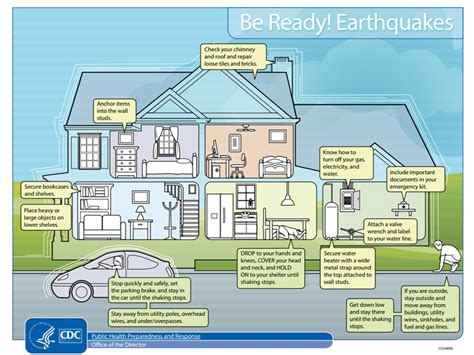The unpredictability of earthquakes in Irvine, California, underscores the importance of preparedness and swift action during such events. Given the region’s seismic activity, residents and visitors alike must prioritize their safety and the safety of those around them. Earthquakes can strike without warning, causing widespread panic and destruction. However, by following a set of well-defined tips and guidelines, one can significantly reduce the risk of injury and property damage. Here are ten crucial tips to enhance safety during an earthquake in Irvine:
Earthquake-Resistant Construction and Retrofitting: Ensuring that buildings, particularly homes and offices, are constructed or retrofitted to be earthquake-resistant is paramount. This involves consulting with structural engineers to assess the building’s integrity and making necessary modifications such as reinforcing foundations, securing heavy objects, and installing earthquake-resistant roofing.
Create an Earthquake Emergency Plan: Developing a comprehensive emergency plan is vital. This plan should include evacuation routes, a designated meeting point outside the home or building, and contact information for all household members. Practicing this plan through regular drills can help ensure everyone knows what to do in case of an earthquake.
Secure Your Space: Securing heavy furniture, bookshelves, and electronics to walls can prevent them from falling and causing injury. Store heavy objects on low shelves and consider installing safety glass on windows and doors. This preparatory work can significantly reduce the risk of accidents.
Stock an Earthquake Emergency Kit: Having an easily accessible emergency kit is crucial. This kit should include essentials such as a first aid kit, a battery-powered radio, flashlights, extra batteries, a whistle to signal for help if needed, a dust mask, and a week’s supply of food, water (at least one gallon per person per day), and any necessary medications.
Stay Informed: Keep abreast of the latest earthquake news and updates. Sign up for emergency alerts from the City of Irvine or Orange County to receive critical information during emergencies. Understanding the potential dangers and knowing how to respond can save lives.
Drop, Cover, and Hold On: During an earthquake, the safest action is to drop to the ground, take cover under a sturdy piece of furniture (such as a table or desk), and hold onto it to protect yourself from falling debris. This is the recommended “drop, cover, and hold on” procedure.
Protect Vulnerable Populations: Special consideration must be given to the elderly, young children, and those with disabilities. Ensure that emergency plans are tailored to meet their specific needs, including having a plan for evacuating them safely and having any necessary equipment or supplies readily available.
Regular Maintenance and Inspections: Regularly inspect your home and workspaces for potential hazards and address them promptly. Ensure that all utilities are installed and maintained according to code, and know how to shut off gas, water, and electricity if necessary.
Be Prepared for Aftershocks: Aftershocks can occur in the days, weeks, months, or even years following an earthquake. Being prepared for aftershocks by having a plan and staying alert can help mitigate additional risks and injuries.
Support Recovery Efforts: After an earthquake, the community’s support for those affected is crucial. Volunteering time, donating to relief funds, and participating in community rebuilding efforts can help the healing and recovery process, fostering resilience and unity within the community.
Implementing These Tips Effectively
To implement these safety tips effectively, it’s essential to approach them with a structured plan:
Start with assessments: Begin by assessing your current level of preparedness, including the structural integrity of your buildings, the readiness of your emergency kit, and your family’s understanding of the emergency plan.
Create a timeline: Set realistic goals and deadlines for completing each preparatory task. This could include weekly tasks such as securing one room at a time or monthly tasks like reviewing and updating the emergency plan.
Involve the community: Share your knowledge and encourage neighbors and colleagues to prepare as well. Community-wide preparedness can significantly enhance overall safety during disasters.
Review and update: Regularly review and update your emergency plan and supplies to ensure they remain relevant and effective.
By following these steps and tips, residents of Irvine can significantly enhance their safety and the safety of their loved ones during an earthquake, turning a potentially catastrophic event into a manageable challenge.
FAQ Section
What are the first steps to take immediately after an earthquake?
+After an earthquake, check for injuries and provide assistance if needed. Next, check for gas and water leaks, and turn off utilities if necessary. Exit the building and move to an open area away from power lines, buildings, and bridges. Finally, follow your emergency plan to contact family members and await further instructions from local authorities.
<div class="faq-item">
<div class="faq-question">
<h3>How often should earthquake drills be practiced?</h3>
<span class="faq-toggle">+</span>
</div>
<div class="faq-answer">
<p>Earthquake drills should be practiced at least twice a year. Regular drills help reinforce the correct actions to take during an earthquake, ensuring that all family members or work colleagues are well-prepared and can respond instinctively in case of an earthquake.</p>
</div>
</div>
<div class="faq-item">
<div class="faq-question">
<h3>What should be included in an earthquake emergency kit?</h3>
<span class="faq-toggle">+</span>
</div>
<div class="faq-answer">
<p>An earthquake emergency kit should include a first aid kit, a battery-powered radio, flashlights, extra batteries, a whistle, a dust mask, and at least a week's supply of non-perishable food, water (at least one gallon per person per day), and any necessary medications.</p>
</div>
</div>
</div>


